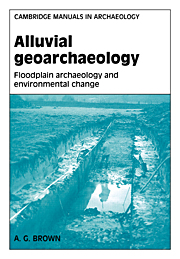Book contents
- Frontmatter
- Contents
- List of illustrations
- List of tables
- Preface
- Acknowledgements
- Introduction and the example of the Nile
- PART I PRINCIPLES
- PART II APPLICATION
- APPENDICES
- Notation
- 1 River flow and sediment transport
- 2 Flood frequency analysis
- 3 Documentary evidence and wetland perceptions
- References
- Subject Index
- Index of rivers and sites
2 - Flood frequency analysis
Published online by Cambridge University Press: 03 December 2009
- Frontmatter
- Contents
- List of illustrations
- List of tables
- Preface
- Acknowledgements
- Introduction and the example of the Nile
- PART I PRINCIPLES
- PART II APPLICATION
- APPENDICES
- Notation
- 1 River flow and sediment transport
- 2 Flood frequency analysis
- 3 Documentary evidence and wetland perceptions
- References
- Subject Index
- Index of rivers and sites
Summary
Standard flood frequency analysis
The most used method of flood prediction is based on the assumption of the random occurrence of floods of a given magnitude. This means that the longer the time period the larger would be the expected flood, i.e. if camping by a river for a month you would be unlikely and unlucky to experience a massive flood; however, living by the river for tens of years you should expect to experience large floods. The average time which elapses between two events of equal magnitude, or exceeding a common level, is the return period or recurrence interval (RI). So the flood with a 100-year return interval would be much larger than that with a 2-year return interval. This does not, however, mean that the 100-year flood cannot occur tomorrow or twice in a year, what it means is that on average it can be expected to occur only once in a 100-year period. It follows from this that the probability analysis of floods is rather more useful for describing past hydrological trends and the design criteria of structures, embankments and bridges (i.e. built to withstand the once in 500 years flood) than it is for flood warning. The calculation is fundamentally simple; the floods over a particular threshold are ranked from largest to smallest and assigned return periods with the largest flood having the return period of the time over which the floods were recorded (i.e. for a 100 years of flood the largest flood has a return period of 100 years).
- Type
- Chapter
- Information
- Alluvial GeoarchaeologyFloodplain Archaeology and Environmental Change, pp. 331 - 332Publisher: Cambridge University PressPrint publication year: 1997



